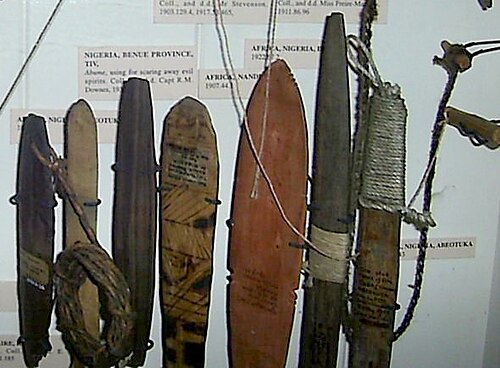Difference between revisions of "AY Honors/Aboriginal Lore/Answer Key"
| Line 23: | Line 23: | ||
Bullroarers are considered [[secret men's business]] by some Aboriginal tribal groups, and hence [[taboo]] for women, children, non-initiated men and/or outsiders to even hear{{Fact|date=February 2007}}. They are used in men's initiation ceremonies and the sound they produced is considered by some Indigenous cultures to represent the sound of the [[Rainbow Serpent]]{{Fact|date=February 2007}}. In the cultures of South-East Australia, the sound of the bullroarer is the voice of [[Daramulan]], and a successful bullroarer can only be made if it has been cut from a tree containing his spirit. | Bullroarers are considered [[secret men's business]] by some Aboriginal tribal groups, and hence [[taboo]] for women, children, non-initiated men and/or outsiders to even hear{{Fact|date=February 2007}}. They are used in men's initiation ceremonies and the sound they produced is considered by some Indigenous cultures to represent the sound of the [[Rainbow Serpent]]{{Fact|date=February 2007}}. In the cultures of South-East Australia, the sound of the bullroarer is the voice of [[Daramulan]], and a successful bullroarer can only be made if it has been cut from a tree containing his spirit. | ||
| − | In [[1987]], [[Midnight Oil]] included a recording of a bullroarer on their album [[Diesel and Dust]] (at the beginning of the song, ''Bullroarer'') inadvertently causing offence{{Fact|date=February 2007}} to the Aboriginal people of [[Central Australia]] from whom the recording was taken. | + | In [[1987]], [[Midnight Oil]] included a recording of a bullroarer on their album [[Diesel and Dust]] (at the beginning of the song, [[Bullroarer (song)|''Bullroarer'']]) inadvertently causing offence{{Fact|date=February 2007}} to the Aboriginal people of [[Central Australia]] from whom the recording was taken. |
The bullroarer can also be used as a tool in [[Aboriginal art]]{{Fact|date=February 2007}}. | The bullroarer can also be used as a tool in [[Aboriginal art]]{{Fact|date=February 2007}}. | ||
Revision as of 07:11, 23 March 2007

A bullroarer or turndun is an ancient ritual musical instrument and means of communicating over extended distances. Along with the didgeridoo, it is prominent technology attributed to Australian Aborigines, though was not exclusively developed by them.
The bullroarer is sometimes used as a means of demonstrating the Doppler effect, by using sound. As the instrument travels round, its sound goes up or down according to its speed, and distance from the hearer.
Design, use, and sound
It consists of a weighted aerofoil, a rectangular slat of wood about 15 cm (6 in) to 60 cm (24 in) long and about 1.25 cm (0.5 in) to 5 cm (2 in) wide, attached to a long cord.
Template:Wikisource1911Enc The cord is given a slight initial twist, and the roarer is then waved in a large circle in a horizontal plane. The aerodynamics of the roarer will keep it spinning about its axis even after the initial twist has unwound. The cord winds fully first in one direction and then the other.
It makes a characteristic roaring vibrato sound with notable modification from both Doppler effect and the changing speed of the roarer at different parts of its circuit.
By modifying the expansiveness of its circuit and the speed given it, the modulation of the sound can be controlled, making the coding of information possible. The low frequency component of the sound travels extremely long distances, especially on the wind.
In culture
This instrument has been used by numerous early and traditional cultures in both the northern and southern hemispheres but in the popular consciousness it is perhaps best known for its use by Australian Aborigines (it is from one of their languages that the name turndun comes).
Australian Aboriginal culture
Bullroarers have accompanied the didgeridoos in initiation ceremonies and in burials to ward off evil spirits, bad tidings, and even women and children.
Bullroarers are considered secret men's business by some Aboriginal tribal groups, and hence taboo for women, children, non-initiated men and/or outsiders to even hearTemplate:Fact. They are used in men's initiation ceremonies and the sound they produced is considered by some Indigenous cultures to represent the sound of the Rainbow SerpentTemplate:Fact. In the cultures of South-East Australia, the sound of the bullroarer is the voice of Daramulan, and a successful bullroarer can only be made if it has been cut from a tree containing his spirit.
In 1987, Midnight Oil included a recording of a bullroarer on their album Diesel and Dust (at the beginning of the song, Bullroarer) inadvertently causing offenceTemplate:Fact to the Aboriginal people of Central Australia from whom the recording was taken.
The bullroarer can also be used as a tool in Aboriginal artTemplate:Fact.
Bullroarers have sometimes been referred to as "wife-callers" by Australian AboriginesTemplate:Fact.
